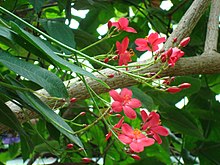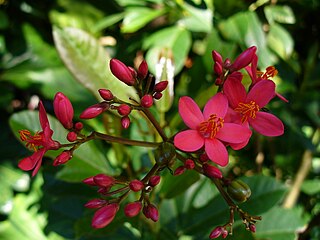
Jatropha is a genus of flowering plants in the spurge family, Euphorbiaceae. The name is derived from the Greek words ἰατρός (iatros), meaning "physician", and τροφή (trophe), meaning "nutrition", hence the common name physic nut. Another common name is nettlespurge. It contains approximately 170 species of succulent plants, shrubs and trees. Most of these are native to the Americas, with 66 species found in the Old World. Plants produce separate male and female flowers. As with many members of the family Euphorbiaceae, Jatropha contains compounds that are highly toxic. Jatropha species have traditionally been used in basketmaking, tanning and dye production. In the 2000s, one species, Jatropha curcas, generated interest as an oil crop for biodiesel production and also medicinal importance when used as lamp oil; native Mexicans in the Veracruz area developed by selective breeding a Jatropha curcas variant lacking the toxic compounds, yielding a better income when used as source for Biodiesel, because of its edible byproduct. Toxicity may return if edible Jatropha is pollinated by toxic types.
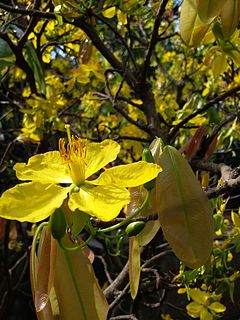
Ochna integerrima, popularly called yellow Mai flower, is a plant species in the genus Ochna and family Ochnaceae. In the wild, it is a small tree or shrub species. The timing of the yellow flowers of this plant make it very popular in southern Vietnam, where plants are purchased during Tết.

Croton is an extensive flowering plant genus in the spurge family, Euphorbiaceae. The plants of this genus were described and introduced to Europeans by Georg Eberhard Rumphius. The common names for this genus are rushfoil and croton, but the latter also refers to Codiaeum variegatum. The generic name comes from the Greek κρότος, which means "tick" and refers to the shape of the seeds of certain species.

Manihot is a genus in the diverse milkspurge family, Euphorbiaceae. It was described as a genus in 1754.

The Kingwood Center Gardens is a historic 47-acre (190,000 m2) site with a house, gardens and greenhouses located in Mansfield, Ohio.

Berberis vulgaris, also known as common barberry, European barberry or simply barberry, is a shrub in the genus Berberis. It produces edible but sharply acidic berries, which people in many countries eat as a tart and refreshing fruit.
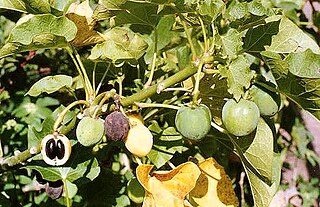
Biofuel development in India centres mainly around the cultivation and processing of Jatropha plant seeds which are very rich in oil (40%). The drivers for this are historic, functional, economic, environmental, moral and political. Jatropha oil has been used in India for several decades as biodiesel for the diesel fuel requirements of remote rural and forest communities; jatropha oil can be used directly after extraction in diesel generators and engines. Jatropha has the potential to provide economic benefits at the local level since under suitable management it has the potential to grow in dry marginal non-agricultural lands, thereby allowing villagers and farmers to leverage non-farm land for income generation. As well, increased Jatropha oil production delivers economic benefits to India on the macroeconomic or national level as it reduces the nation's fossil fuel import bill for diesel production ; minimising the expenditure of India's foreign-currency reserves for fuel allowing India to increase its growing foreign currency reserves. And since Jatropha oil is carbon-neutral, large-scale production will improve the country's carbon emissions profile. Finally, since no food producing farmland is required for producing this biofuel, it is considered the most politically and morally acceptable choice among India's current biofuel options; it has no known negative impact on the production of the massive amounts grains and other vital agriculture goods India produces to meet the food requirements of its massive population. Other biofuels which displace food crops from viable agricultural land such as corn ethanol or palm biodiesel have caused serious price increases for basic food grains and edible oils in other countries.
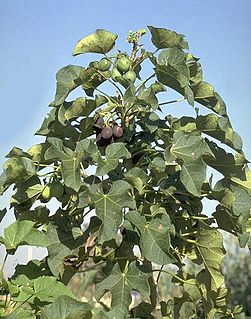
Jatropha curcas is a species of flowering plant in the spurge family, Euphorbiaceae, that is native to the American tropics, most likely Mexico and Central America. It is originally native to the tropical areas of the Americas from Mexico to Argentina, and has been spread throughout the world in tropical and subtropical regions around the world, becoming naturalized or invasive in many areas. The specific epithet, "curcas", was first used by Portuguese doctor Garcia de Orta more than 400 years ago. Common names in English include physic nut, Barbados nut, poison nut, bubble bush or purging nut. In parts of Africa and areas in Asia such as India it is often known as "castor oil plant" or "hedge castor oil plant", but it is not the same as the usual castor oil plant, Ricinus communis.
China has set the goal of attaining one percent of its renewable energy generation through bioenergy in 2020.

Jatropha podagrica is a succulent plant in the family Euphorbiaceae. It is native to the tropical Americas but is grown as an ornamental plant in many parts of the world due to its unusual appearance. Common names include Gout Plant, Gout Stalk, Guatemalan Rhubarb, Coral Plant, Buddha Belly Plant, Purging-Nut, Physic Nut, Goutystalk Nettlespurge, Australian Bottle Plant, and Tartogo.

Astrolepis is a small genus of ferns in the family Pteridaceae. It was formed in 1992 from species previously placed in Cheilanthes and Notholaena. The name is derived from the Greek words ἄστρον, meaning "star," and λεπίς, meaning "scale," referring to the star-like scales on adaxial blade surfaces. Members of the genus are commonly known as star-scaled cloak ferns and are native to the Americas.

Jatropha cathartica is a species of flowering plant in the spurge family, Euphorbiaceae, that is native to Texas in the United States and Coahuila, Nuevo León and Tamaulipas in northeastern Mexico. Common names include jicamilla (Spanish) and Berlandier's nettlespurge.
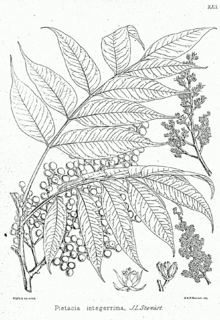
Pistacia integerrima is a species of pistachio tree native to Asia, commonly called zebrawood. It is often classified as Pistacia chinensis ssp. integerrima. It is used for a variety of purposes in India, including timber, dye, and fodder. The leaf galls are used in traditional herbalism for cough, asthma, fever, vomiting, and diarrhea.

Global Clean Energy Holdings (OTC:GCEH) is a Southern California-based renewable energy company focused on the production and commercialization of non-food based feedstocks used for the production of biofuels, biomass and renewable chemicals.
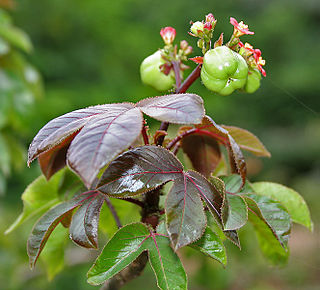
Jatropha gossypiifolia, commonly known as bellyache bush, black physicnut or cotton-leaf physicnut, is a species of flowering plant in the spurge family, Euphorbiaceae. The species is native to Mexico, South America, Gujarat State (India) and the Caribbean islands. It is a declared noxious weed in Puerto Rico and is naturalised in northern Australia, including Queensland where it is listed as a Class 2 declared pest plant. It grows to 2.5–4 m (8.2–13.1 ft) high. The three lobed leaves are purple and sticky when young and become bright green with age. The small red flowers with yellow centres appear in clusters. These are followed by cherry-sized seed pods that are poisonous. Powdery mildew fungal disease was reported.

Jatropha dioica is a species of flowering plant in the spurge family, Euphorbiaceae, that is native to Texas in the United States as well as Mexico as far south as Oaxaca. Common names include leatherstem and sangre de drago. The specific name refers to the dioecious nature of the plants.
The flora of the Dominican Republic is diverse.

Kodeboyina Sivannarayana Varaprasad is an Indian agricultural scientist, Nematologist and the Director of Indian Institute of Oilseeds Research, Rajendranagar, Hyderabad. He was former Head of NBPGR, Regional Station at Hyderabad for about a period of 26 years. and was associated in the development of 11 genetic stocks in tomato, linseed, jatropha, cowpea, chilli and sorghum. Dr.K.S.Varaprasad is recipient of Late Sri P.P. Singhal Memorial Award, 2015.
Goodenia integerrima, commonly known as gypsum goodenia, is a species of flowering plant in the family Goodeniaceae and is endemic to the south-west of Western Australia. It is a low-lying to ascending, perennial herb with linear leaves clustered on the stems, and umbels of yellow flowers with a brownish centre.
